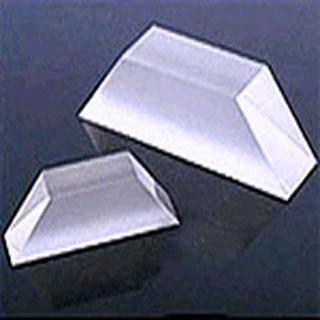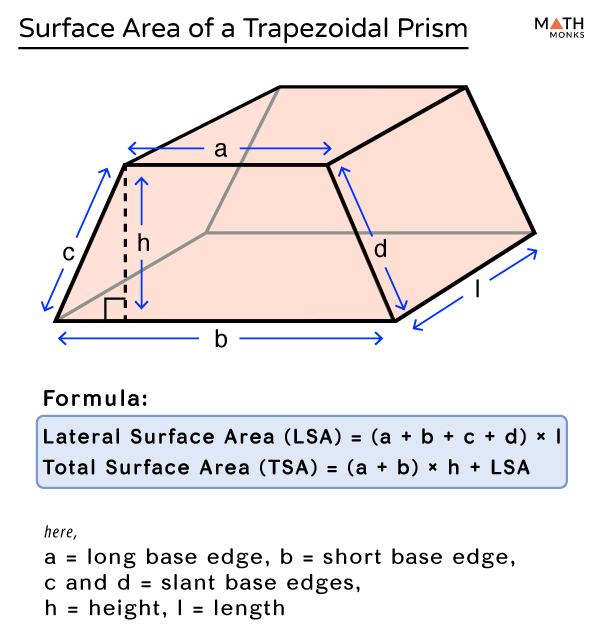

Thus, the simple formula for calculating the surface area of a trapezoidal prism involves the area of the base, the perimeter of the base, and the slant height of any side of the prism. A trapezoidal prism has two trapezoidal faces four rectangular faces. The surface area of any three-dimensional geometrical shape is the sum of the surfaces of that enclosed solid which equals the areas of all of the faces. Since the trapezoidal prism has a flat base, thus we can say that it has a total surface area and a curved surface area. The area occupied by the surface of a trapezoidal prism is known as the surface area of a trapezoidal prism.
#RIGHT TRAPEZOIDAL PRISM HOW TO#
How to Calculate the Surface Area of a Trapezoidal Prism?įAQs on Surface Area of Trapezoidal Prism What is the Surface Area of Trapezoidal Prism?įormula of Surface Area of Trapezoidal Prismĭerivation of Surface Area of Trapezoidal Prism Let's explore and learn more about the surface area formula of a trapezoidal prism using solved examples. Like all three-dimensional shapes, you will learn how to calculate the surface area of a trapezoidal prism. A trapezoidal prism is a three-dimensional solid that is made up of two trapezoids on opposite faces which are joined by four rectangles called the lateral faces. Finally, connect the remaining sides of the rectangle to complete the prism.The surface area of a trapezoidal prism is the amount of area occupied by the surface of a trapezoidal prism. Next, draw two more lines connecting the ends of the parallel lines. Then, draw two lines parallel to the sides of the rectangle. To draw a trapezoidal prism, start by drawing a rectangle. The formula for trapezoidal prism is V = (1/2)*h*(b1+b2)*l, where h is the height, b1 and b2 are the lengths of the bases, and l is the length. What is the formula for trapezoidal prism? The top and bottom faces are trapezoids, while the other four faces are rectangles.Ī trapezoidal prism can be thought of as a rectangular prism with two of its six faces replaced by trapezoids. The trapezoidal prism shares properties with other prisms, polygons, rectangles, and parallelograms.Ī trapezoidal prism is a three-dimensional geometric shape with two parallel faces and four equal sides. In conclusion, a trapezoidal prism is a 3D shape with six faces that consisting of two parallel rectangles and four triangles. It also shares properties with other geometric shapes, such as rectangles and parallelograms" The trapezoidal prism shares some properties with other prisms, including having identical ends (bases), being enclosed by lateral faces, being composed of polygons, having perpendicular lateral faces, and having Parallel bases." It also has rotational symmetry if you turn it by 180°"Ī trapezoidal prism is three-dimensional shape with six rectangular or triangular faces that enclose a space. The sum of the degrees of the angles of any quadrilateral is 360°."Ī rectangle has horizontal and vertical lines of symmetry. The diagonals of a rectangle bisect each other and meet at right angles."

A parallelogram with four unequal sides is called an irregular quadrilateral since it does not have many features (such as parallel opposite sides) that define most other quadrilaterals."

All the angles of a rectangle measure 90 degrees"Ī rectangle is sometimes also called an oblong. The opposite sides of a rectangle have equal lengths. Its diagonals also bisect each other as they do in a rhombus but do not intersect at right angles as they do in a square." It has features in common with both squares and rhombuses however, its diagonal lengths are not equal as they are in a square nor are its angles always 90 degrees as they are in a rhombus. Of all parallelograms, a rectangle is both the most symmetric and has the most properties in common with other shapes.

Because of this, the trapezoidal prism has two bases (the top and bottom), four lateral faces, and two side faces.Īll sides of a trapezoidal prism are rectangles or triangles. Two of the rectangles are parallel to each other, and the other two rectangles are also parallel to each other but at a different angle than the first two. The faces are made up of two rectangles and four triangles. It consists of six faces (sides), eight vertices (corners), and twelve edges. A trapezoidal prism is a type of three-dimensional (3D) shape.


 0 kommentar(er)
0 kommentar(er)
